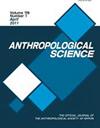中国南方更新世水螅体磨牙化石形态计量学分析
IF 0.8
4区 社会学
Q3 EVOLUTIONARY BIOLOGY
引用次数: 7
摘要
本文研究了广西崇左地区8个新发现的更新世洞穴遗址中28个长臂猿臼齿化石的形态变异和分类亲缘关系。最近的一项描述性分析表明,这些化石牙齿形成了一个统一的群体,可以分配给一个单一的Nomascus物种。在这篇论文中,我们采用二维形态计量学方法,将崇左的标本与大量现存的舌虫样本以及先前报道的来自中国更新世的舌虫牙齿遗骸进行了比较。颊舌和中远端测量和冠轮廓区域显示崇左磨牙与Nomascus磨牙最接近,在较小程度上与Hoolock磨牙相似。用椭圆傅里叶分析研究了冠形。结果表明,崇左标本多数情况下属于现有Nomascus的变异范围内,排除了所有其他球虫属,或者与Nomascus样本所代表的集群距离相对较小。同样,Mahalanobis的冠形距离在崇左标本与Nomascus之间呈现出较小的形态距离趋势,其次是Hoolock和hyloates。崇左的臼齿在形态上也不同于绢布猿,但与中国南方其他更新世的舌形齿骸有重叠的范围。证据的平衡表明崇左牙齿可以归因于cf. Nomascus。化石的牙齿与现存的Nomascus的牙齿有足够的区别,它们可能代表了一个灭绝的物种。本文章由计算机程序翻译,如有差异,请以英文原文为准。
Morphometric analysis of fossil hylobatid molars from the Pleistocene of southern China
This study investigates the morphological variation and taxonomic affinities of 28 fossil gibbon molars from eight newly discovered Pleistocene cave sites in the area of Chongzuo, Guangxi Zhuang Autonomous Region, China. A recent descriptive analysis demonstrated that these fossil teeth form a uniform group that can be assigned to a single species of Nomascus . In this contribution, a two-dimensional morphometric approach is employed to examine the Chongzuo specimens in comparison with a large sample of extant hylobatids, as well as with previously reported hylobatid dental remains from the Pleistocene of China. Buccolingual and mesiodistal measurements and crown outline areas reveal that the Chongzuo molars correspond most closely with Nomascus and, to a lesser extent, Hoolock . Crown shape was investigated using elliptical Fourier analysis. Our results show that the Chongzuo specimens fall in most cases either within the range of variation of extant Nomascus to the exclusion of all other hylobatid genera, or their distance from the cluster represented by the Nomascus sample is relatively small. Similarly, the Mahalanobis distances for crown shape show a trend towards smaller morphological distances between the Chongzuo specimens and Nomascus , followed by Hoolock and Hylobates . The Chongzuo molars are also morphometrically distinct from Bunopithecus sericus , but fall within the range of overlap of other Pleistocene hylobatid dental remains from southern China. The balance of evidence indicates that the Chongzuo teeth can be attributed to cf. Nomascus . The fossil teeth are sufficiently distinct from those of extant Nomascus that they may represent an extinct species.
求助全文
通过发布文献求助,成功后即可免费获取论文全文。
去求助
来源期刊

Anthropological Science
生物-进化生物学
CiteScore
1.50
自引率
0.00%
发文量
7
审稿时长
>12 weeks
期刊介绍:
Anthropological Science (AS) publishes research papers, review articles, brief communications, and material reports in physical anthropology and related disciplines. The scope of AS encompasses all aspects of human and primate evolution and variation. We welcome research papers in molecular and morphological variation and evolution, genetics and population biology, growth and development, biomechanics, anatomy and physiology, ecology and behavioral biology, osteoarcheology and prehistory, and other disciplines relating to the understanding of human evolution and the biology of the human condition.
 求助内容:
求助内容: 应助结果提醒方式:
应助结果提醒方式:


